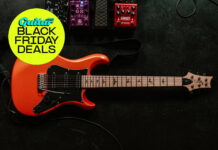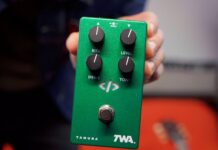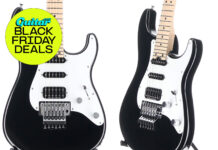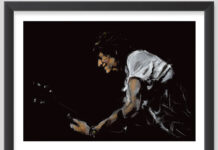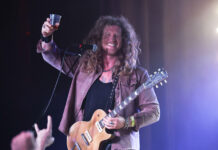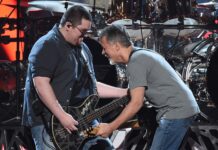
“We just looked at each other in awe” the truth behind why Jimi Hendrix started smashing guitars on stage
In the era before global stadium tours and mega-festivals took over the musical landscape, the package tour was a popular and common way for music fans to see a bunch of their favourite bands in one go.
One of the last great examples of this phenomenon occurred in November and December 1967, and featured a monster line-up of The Jimi Hendrix Experience, Pink Floyd, The Move, The Nice, Amen Corner, Eire Apparent and The Outer Limits.
READ MORE: The Gear Used on Are You Experienced by the Jimi Hendrix Experience
The tour itself was 16 dates and 31 shows, with two shows per night, and each band given strict time slots – Hendrix got 40 minutes, while openers like The Outer Limits got just eight minutes to win new fans.
This tour featured a remarkable contingent of personalities that would go on to find greater fame elsewhere. Hendrix and Floyd obviously became legends, but elsewhere, Amen Corner’s Andy Fairweather Low went onto work with Eric Clapton and Roger Waters. Keith Emerson from The Nice went on to find fame with Emerson Lake & Palmer, Henry McCulloch from Eire Apparent moved to Wings and The Outer Limits’ Jeff Christie went on to form Christie, who had a worldwide hit and UK number one in 1970 with Yellow River. Even Hendrix’s roadie, Ian Kilmister, would later reinvent himself as Lemmy.
But Hendrix was the star of the show – he’d had three top 10 singles in the UK before the tour kicked off, and Axis: Bold As Love would arrive midway through. It was also a pivotal moment in the evolution of Hendrix’s remarkable stage persona – the guitarist becoming ever more wild and untamed, and developing an appetite for guitar destruction that would become almost as iconic as his musicianship.
The Quiet Ones
Off stage however, Jimi was a very different character. “Jimi would travel separately and as a rule you wouldn’t see much of him until he was just about to go on stage,” recalls Outer Limits frontman and guitarist Christie. “He was quite shy and would often just amble by you with a shy smile and make little asides like, ‘Gee, I hope my hair ain’t too messed up’.”
Each night Christie would position himself side of the stage and watch Hendrix’s spellbinding performances, and was one of the first to witness first hand Hendrix’s electrifying guitar demolitions.
“I would watch Jimi from the wings and watch the audience responses too,” explains Christie. “And on one particular occasion at Newcastle City Hall, he was having problems with the tuning of his Gibson Flying V and getting increasingly frustrated trying to keep it in tune. He would sometimes close his set with The Troggs’ Wild Thing as he did on this occasion and would work the top line of Strangers in the Night into his guitar solo, which was a little bizarre, but at the same time, brilliant even though totally off the wall.
“It got so bad that he finally lost patience, turned and threw his Flying V at his Marshall stack from roughly a seven-yard distance. Instead of either missing or falling short, it hit bull’s eye centre speaker, quivering with feedback way north of 11 whilst emitting some sort of smoke from the stricken amp as it rocked back and forth under the assault. With Lemmy standing behind it to stop it toppling over!”
Hendrix’s impromptu bit of gear destruction was infectious, and one his Experience bandmates soon joined in.
“Mitch Mitchell, not to be outdone, then kicked over his drum kit, Keith Moon style, leaving Noel Redding, sole survivor, grimly trying to carry on playing bass,” Christie explains. “The whole stage now was a demolition zone. I was standing in the wings watching next to Carl Wayne of The Move and we just looked at each other in awe as did much of the audience who went ballistic and loving every minute of it! All orchestrated with the distortion guitars and bass feedback and crashed cymbals. Mayhem, madness, and drama – how do you follow that? You don’t!”
Smash and Grab
While artists smashing their gear on stage wasn’t unheard of at this point, as a guitarist and musician, there was a part of Christie that winced at the wanton gear carnage.
“A part of me was horrified at that beautiful guitar’s broken and burnt demise,” he admits. “Not to mention collateral damage to drums, mics and amps, particularly as we less successful groups, were so short of funds to buy or maintain equipment. But at the same time, recognising this as shock and awe rock and roll theatre, although it wasn’t new, as Townshend and Moon had already paved the way.”
With Hendrix’s growing popularity as the new guitar hero on the block, one that was taking the mantle away from Eric Clapton who had been previously been proclaimed ‘God’ when it came to his guitar prowess, it sparked outrage by Clapton acolytes.
“In the interval at one show, some girl somehow got backstage into this large communal area where everyone was hanging around,” Christie begins. “Somehow, she found Hendrix and started berating him in front of everyone telling him he wasn’t as good as Clapton. To his credit he just shuffled off grinning and left her shouting after him, while Lemmy and some other crew member bundled her out of the area.”
Looking back on that tour, Christie says he cherishes his memories of having been part of such a momentous occasion and one that defined the Hendrix legacy.
“It’s one thing to hear about it [the smashing of guitars] and another to actually be there and see it as it happens live,” he says. “All tours have a degree of stress and fatigue components plus artists have personal lives and whatever baggage they carry but even if all is sunny and bright, but if things go badly wrong on stage and are unfixable, any performer is going to get pretty stressed, especially if drugs and alcohol have been partaken of before-hand, and also don’t forget, it was the 60s, man.”
The post “We just looked at each other in awe” the truth behind why Jimi Hendrix started smashing guitars on stage appeared first on Guitar.com | All Things Guitar.
Source: www.guitar-bass.net

